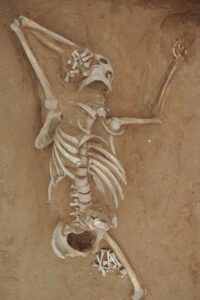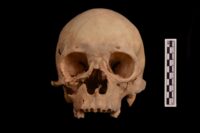 A skeleton found in a shaft dug by grave robbers of an ancient tomb at Shiyanzi cemetery in Shiyanzi village, Ningxia region, northwest China, has been revealed to be a murder victim whose body was thrown down the shaft. Similar finds of human remains in the looter’s shafts of ancient Chinese tombs have been made before, but they all showed evidence of having been the actual looters who died by misadventure during the act. This young man was not involved in the robbery, but rather a victim of a violent assault whose body was disposed of in a convenient and well-camouflaged hiding place.
A skeleton found in a shaft dug by grave robbers of an ancient tomb at Shiyanzi cemetery in Shiyanzi village, Ningxia region, northwest China, has been revealed to be a murder victim whose body was thrown down the shaft. Similar finds of human remains in the looter’s shafts of ancient Chinese tombs have been made before, but they all showed evidence of having been the actual looters who died by misadventure during the act. This young man was not involved in the robbery, but rather a victim of a violent assault whose body was disposed of in a convenient and well-camouflaged hiding place.
The cemetery was discovered in 2002 and excavated between 2009 and 2011. Of the 12 tombs found, 10 date to the Han Dynasty (202 B.C. – 220 A.D.), with the remaining two dating much later to the Song (960–1279 A.D.) or Yuan (1271–1368 A.D.) dynasties. One of the Han tombs, M12, was a large wooden chamber tomb 194 square feet in area. A downwards passage lef to a burial chamber containing the remains of three individuals, likely family members. The tomb belonged to people with wealth, and the large mound that originally topped it was basically a neon sign to tomb raiders that there was valuable stuff to be found inside. Most of its grave goods were robbed more than a thousand years ago, but archaeologists did find bronze, iron, lead and jade artifacts, pottery and 57 Wu Zhu coins.
 The shaft dug by the tomb raiders was unusually large and more than 20 feet long from the surface to the burial chamber directly below. It was partially filled in by sediments from the surface when the tomb collapsed. A complete human skeleton was found slumped on the fill about 6.5 feet below the surface, his right hand still raised in a protective gesture over the right side of his face. Radiocarbon analysis of a bone sample from the skeleton in the shaft dates him to the early Tang Dynasty, 640–680 A.D. A bone sample taken from one of the occupants of the tomb returned a radiocarbon date of 155–135 A.D., the middle of the East Han Dynasty.
The shaft dug by the tomb raiders was unusually large and more than 20 feet long from the surface to the burial chamber directly below. It was partially filled in by sediments from the surface when the tomb collapsed. A complete human skeleton was found slumped on the fill about 6.5 feet below the surface, his right hand still raised in a protective gesture over the right side of his face. Radiocarbon analysis of a bone sample from the skeleton in the shaft dates him to the early Tang Dynasty, 640–680 A.D. A bone sample taken from one of the occupants of the tomb returned a radiocarbon date of 155–135 A.D., the middle of the East Han Dynasty.
Osteological examination and CT scans of the M12 robbery shaft skeleton found 13 sharp-force marks, eight on the skull, four on the ribs and one on the forearm. They were inflicted from the front and from the back of him, suggesting there may have been more than one attacker slashing at the victim at the same time. Most of the wounds are v-shaped in cross-section, so inflicted by a double-edged bladed weapon. A rusted sword blade missing its handle was found two feet above the skeleton in the shaft. It is unclear if this weapon is related to the assault.
 There are no other signs of trauma, illness or pathology that could have caused sudden death. There is no bone regeneration at the injury sites, indicating they were all suffered at or just before the time of death. The fatal blow was likely one of the ones that resulted in the rib injuries, penetrating his heart and/or lungs.
There are no other signs of trauma, illness or pathology that could have caused sudden death. There is no bone regeneration at the injury sites, indicating they were all suffered at or just before the time of death. The fatal blow was likely one of the ones that resulted in the rib injuries, penetrating his heart and/or lungs.
“The skeleton belongs to a young and healthy individual,” says anatomist and anthropologist Qian Wang, professor in the Department of Biomedical Sciences at Texas A&M University College of Dentistry in the US, and lead author of the study. […]
“We conclude with confidence that the assault victim was not part of the original robbery team based on the fact that the filling of the vertical robbery shaft had accumulated naturally, and the victim was found about 4.5m above the floor of the burial chamber—which means it should be a significant long time after the robbery,” Wang says. […]
“This discovery is one of a kind. All links to this homicide case have been lost to history,” Wang says. He adds that when describing the trauma and picturing the crime scene, he thought that though the research team can’t bring the murdered man justice, they will prove him innocent of grave robbery. “In this regard, I think we did a good job that brings peace of mind.”
The study has been published in the journal Archaeological and Anthropological Sciences and can be read here.